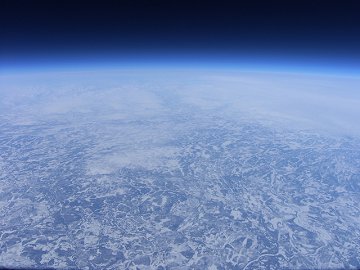 Did you miss last night's auroras? Next time get a wake-up call from Spaceweather PHONE.
Did you miss last night's auroras? Next time get a wake-up call from Spaceweather PHONE.
AURORA WATCH: Sky watchers from Scandinavia to Alaska should be alert for auroras tonight. Earth is entering a solar wind stream, and this could cause a geomagnetic storm.
VENUS AND THE PLEIADES: When the sun goes down tonight, step outside and look west. Brilliant Venus and the delicate Pleiades are almost side-by-side. Juan Ivaldi of Redding, Connecticut, took this picture last night:

"It was a beautiful night and I couldn't resist taking out the camera to capture Venus and the Pleiades. The trees and thin clouds add a nice dramatic effect," he says.
The view will improve in the nights ahead as the planet and the star cluster draw even closer together. They'll be at their best on Wednesday, April 11th, when only 2.5o degrees of arc lie between them, and you can eclipse the pair with the tip of your thumb held at arm's length. Don't miss it! [finder chart]
more images: from Ivica Skokic of Semovci, near Djurdjevac, Croatia; from Mohammad Taher Pilevar of Hamedan, Iran; from Mila Zinkova of San Francisco, California; from Günther Strauch of Borken, NRW, Germany; from Becky Ramotowski of Tijeras, New Mexico; from Koen Miskotte of Ermelo, the Netherlends.
STRATOSPHERIC PHOTOGRAPHY: Consider it a test flight. Swedish University students Jörgen Hedin and Michael Erneland wondered what it would be like to send an ordinary digital camera into the stratosphere and take a picture of the scenery. So on March 28th they launched a weather balloon with a Samsung DigiMax Pro 815 onboard, and here is the result:

"This photo was taken about two and a half hours into the flight at an altitude of 25 km," says Hedin. "The balloon was straight above the city of Rovaniemi in Finland. In the high resolution image one can see the Swedish/Norwegian mountains in the distance."
At an altitude of 25 km, the balloon was above 95% of Earth's atmosphere. The air was only a few percent as dense as air at sea level, and the temperature was about 55 degrees C below zero. These are conditions typical of the planet Mars! How appropriate that the black of space is visible just over the horizon.
The test flight was a big success and more flights are planned. Stay tuned for photos of meteors, auroras, stars and planets--the possibilities are stratospheric.

